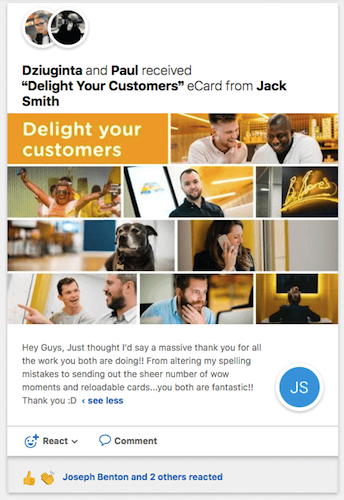Recognition has become an essential tool for companies to use to engage with their employees. And it is no surprise since appreciation and recognition are fundamental human needs. When you recognise someone for doing a good job, they feel valued and that their actions have a larger impact on the team, the customer and the company.
These feelings lead to better satisfaction and increased engagement, which leads to increased productivity, motivation, creativity and innovation (to name a few).
Discover six tips for building a culture of continuous recognition, where everyone understands why appreciating each other is important and how they can do it every day. This will make recognition approachable for your team – and most of them only take a minute!
.jpg?width=500&name=Audience%20(1).jpg)
1. Shine a spotlight on various teams
Highlight a recognition or success at the start of your daily huddle, weekly meetings, monthly check-in or other recurring time you have in front of your people.
Put it on the agenda and give it a name if you’d like. For example, you could call it the “Company Experience in Action” or “Recognition Corner.” At Reward Gateway, our U.S. team calls it “successes.” We take five minutes at the start of our fortnightly team meeting and open the floor for anyone to share stories from over the past two weeks.
Not only does this start the meeting off on a high note by letting us celebrate and reflect on what’s going well, it also gives us an opportunity to highlight the actions of people and teams that others in the group may not hear about day-to-day and improves employee connections.
2. Focus on specific values
Take one of your company values or an aspect of the experience you strive to deliver internally as an organisation and externally to customers. As a team, discuss what the impact is when the team does it really well for a set period of time. For example, a desirable behaviour could be going above and beyond to help a teammate meet their goals.
Identify the different actions or behaviours that contribute to this success.
Keep in mind, your team will be more motivated if you explain why they are going on this particular mission. Once you have narrowed down your focus, send your team on a mission to act in ways that deliver on the value or aspect of the experience, as well as to recognise others they catch doing so.
Follow up with your team in a week to check in on progress, discuss obstacles or challenges and share examples of success.
3. Pick a business result to celebrate
If you regularly measure behaviours or actions that support specific team goals, you will probably already have a good sense of an area to zero in on. If you’re not measuring this type of thing as a team, consider a broader, company-wide focus area from your annual survey or related to your company’s purpose, mission or values. For example, what are the company goals for the quarter? How can your team help achieve them?
No matter what the focus area, it’s key to clearly communicate why you’re sharing an employee survey and remind people about the impact that it can have on the company or on them personally. Again, with this type of reminder, check in with your team periodically to measure progress and celebrate success.
Introducing a new initiative to your team is a formula of 1% training and 99% reminding.

4. Streamline recognition efforts
Establishing an employee reward and recognition system where people on your team can recognise each other on-the-spot, in real time helps build the habit of showing appreciation and gratitude on a day-to-day basis. One way your program can do this is through eCards.
eCards are a simple, creative and environmentally-friendly way to start building a culture of continuous recognition.
Whether your programme is designed to be peer-to-peer, manager-led or both, being able to say congratulations on a job well done or “wow, you impressed the team with your skills” goes a long way.
Taking your peer-to-peer eCards a step further and posting them to a central feed or “wall” lets everyone in your company see, share, comment and react to the great work going on around them – increasing visibility and embedding continuous recognition in your company culture.
5. Celebrate customer feedback
Everyone loves to hear that their work is appreciated by customers and clients, so share and celebrate customer feedback when you receive it.
Gathering feedback from customers can be a really useful way to hear about the great work of your team, especially if you are a leader who doesn’t have that much visibility into the day-to-day operations (e.g., if you’re on the road or out of the office for extended periods of time).
Another benefit is that people are more likely to repeat the actions and behaviours that led to the happy customer, meaning more happy customers overall. .jpg?width=500&name=Grace%20Lancer-1777%20(1).jpg)
6. Be transparent about personal goals
Share personal goals and show your team that you take your company values and culture seriously. Your goal doesn’t have to be big. In fact, it should be something you can actually accomplish.
Share your reasons for choosing your particular goal so your team understands the why and the impact you are looking to achieve.
You can also ask your team to help hold you accountable to what you said you are going to, helping you accomplish your goal by speaking up if they see you falling short. Extend this tactic to your team, perhaps in a one-on-one environment – encouraging them to share their personal goals and pick accountability partners to share progress with week to week.
Remember to recognise each other as you make incremental progress to achieving your goals!
Consistently sharing messages of success and setting positive expectations as part of regular meetings supports your team in focussing on what is working and on solutions rather than on problems and obstacles.
That’s the driving force behind each of these different tactics for infusing your work culture with recognition. These quick reminders are a great way to consistently demonstrate your own commitment to living your company’s core values and setting expectations for your team to do the same.
Which of these tips will you put in your recognition toolbox to build a culture of appreciation?

%20(1).jpeg) Alexandra Powell
Alexandra Powell

